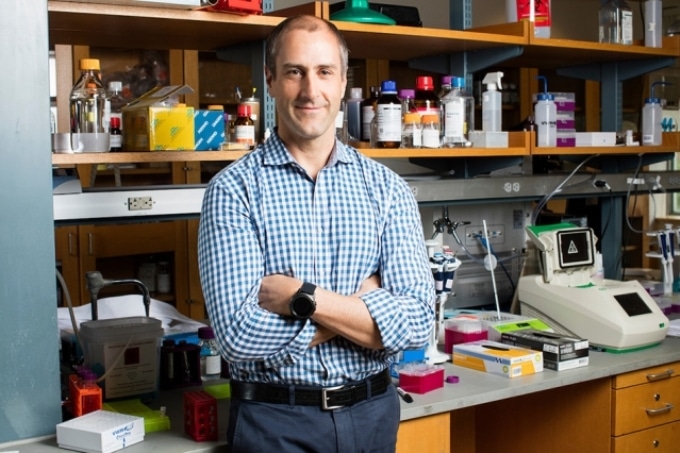Jun 5 2017
The founding mission of MIT may seem like an unusual meal-time story for a child. But, when Mark Bathe was growing up, it was a regular topic of conversation around the dinner table.
 Mark Bathe, Associate Professor in MIT’s Department of Biological Engineering. CREDIT: M. Scott Brauer.
Mark Bathe, Associate Professor in MIT’s Department of Biological Engineering. CREDIT: M. Scott Brauer.
This was due to the fact that Mechanical Engineer Klaus-Jürgen Bathe, was Mark Bathe’s father. He was a proud faculty member of MIT for a long time and often talked about MIT Founder William Barton Rogers’ mission for the Institute.
Bathe’s Father was a huge presence his childhood. His Father’s enthusiastic descriptions of MIT’s emphasis on basic but hands-on science to benefit society left a deep impact on Bathe. “My father was the lens through which I saw the world,” stated Bathe.
So when Bathe was accepted to both MIT and another University as a senior in High School, there was little doubt in his mind as to where he would be enrolling.
As an Undergraduate, Bathe joined the Department of Mechanical Engineering at MIT, and he regards himself to be lucky to have been trained in a fundamental and broad manner, which was problem-oriented at the same time.
However, his long time passion to enhance human health through medicine led Bathe to move on to Biomechanical Engineering Graduate research, partially under the stewardship of Alan Grodzinsky, a Professor of Biological, Mechanical, and Electrical Engineering, who is the Director of the MIT Center for Biomedical Engineering.
Upon acquiring his PhD in the year 2004, Bathe resolved to strengthen his knowledge of biomolecules by relocating to the University of Munich in the year 2006 to pursue Postdoctoral research in Biological Physics.
In the year 2009, he returned to MIT to join the Department of Biological Engineering to form an interdisciplinary research team that concentrated on applying techniques from Chemistry, Engineering, Computer Science and Physics to perceive and overcome challenges in Applied Biology.
I find the new emerging world of personalized medicine fascinating. In particular, the prospect of using gene-editing tools to correct disease-causing mutations that are either inherited or acquired, as well as the use of messenger RNAs to express specific proteins that are needed to alleviate disease.
Professor Mark Bathe, Associate Professor of Biological Engineering, MIT
At present, Bathe is an associate professor of biological engineering at MIT, and is contributing to develop a vast variety of programmed three-dimensional shapes from single strands of synthetic DNA. This process is called as DNA origami. According to Bathe, the developed nanoparticles can be eventually used as structural scaffolds for delivering drugs, vaccines or even gene-editing tools such as CRISPR-Cas9 to particular parts of the body.
Upon being delivered, the therapeutic payload can be released, thereby modifying the defective genes that cause specific diseases.
It amazes me that with two therapeutic tools, namely CRISPR for gene editing and therapeutic messenger RNAs for protein production, we could, in principle, cure nearly any disease, potentially with minimal side-effects, but only if we can figure out how to successfully deliver these tools to act highly specifically in the target cells of interest, such as the gut, lungs, brain, or other organs.
Professor Mark Bathe, Associate Professor of Biological Engineering, MIT
Bathe considers that this challenge can be overcome only by means of long-term, interdisciplinary research.
“Targeted therapeutic delivery is a highly interdisciplinary problem, involving everything from very applied, clinical medicine to basic macromolecular chemistry of nucleic acids and proteins, as well as the physics and engineering of macromolecular transport,” stated Bathe.
To initiate the effort, Bathe along with Chemists, Engineers, Physicists, and Computer Scientists from his laboratory created DAEDALUS, i.e. DNA Origami Sequence Design Algorithm for User-defined Structures, an algorithm created for the automation of the technique for assembling DNA nanoparticles. DAEDALUS has the ability to construct any kind of enclosed 3-D shape by taking a simple 3-D representation of the object and determining the way in which it can be assembled from the DNA strands.
Consequently, the algorithm—including innovative nucleic acid synthesis procedures reported in a paper published in the Science journal the previous year—has enabled Bathe and his colleagues to develop the nanoparticles in an easier and more rapid way than before.
Bathe said that although many years of research have gone into the delivery of proteins and nucleic acids, and substantial prospects for using this therapeutics in clinical medicine, little progress has been achieved as estimated by FDA-approved therapies. This is partially because of the lack of knowledge of macromolecular transport in the complex human anatomy, and also because of the insufficient technology at disposal for engineering delivery tools, added Bathe.
We’re hopeful that fully synthetic, viral-like nucleic acid nanoparticles developed in our lab offer a new opportunity for the rational engineering of delivery tools for gene-centric therapies.
Professor Mark Bathe, Associate Professor of Biological Engineering, MIT
In collaboration with the Stanley Center for Psychiatric Research, Bathe and his colleagues are also analyzing innovative techniques for imaging patient-derived neuronal cells for acquiring in-depth knowledge of the way in which genes affect the signals sent between the brain’s individual neurons.
Bathe is also analyzing the application of DNA and other molecules for storing and processing information having density of the order of magnitude greater than traditional silicon-based computing hardware.
When Bathe is away from his laboratory or classroom, he participates in many outdoor activities such as skiing, cycling, hiking, running, and also indoor swimming along with MIT’s Master’s Swim Team. He also loves to participate in occasional sprint triathlons on summer weekends.
“My favorite weekend in the Boston area, however, is a ferry ride down to Martha’s Vineyard for a bike ride around the island, ending with a swim and lobster roll by the seaside in Edgartown,” stated Bathe. “I can’t recommend it highly enough!”